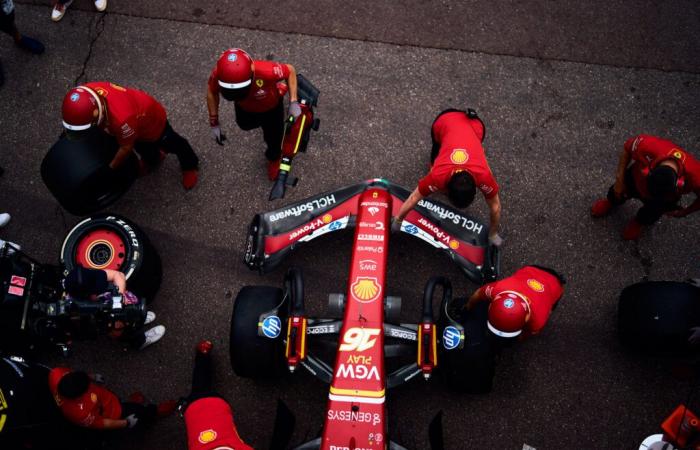Ferrari must recover the unfortunate man weekend Of F1 spent on the island Of Notre Dame. A competitive context where the redhead got everything wrong. A double zero that hurts, scares in some ways. Much criticism has fallen regarding the competitiveness of the team, because according to some it wasn’t the tires or the incorrect set-up that gave rise to the subpar performance. According to our analyses, 80% of the problem was linked to the hysteresis cycle, while the remaining 20% was due to a non-optimal setup in cold and wet track conditions.
The opportunity to make up for it arrives Spaincircuit of F1 always considered a test bed for every car. It is no coincidence that many teams have always brought large update packages. The layout it has undergone changes in recent years and the average speeds have been increased. The last stretch has changed in the line of turn 1: the last chicane has been replaced with a medium-high speed right-handed corner. Changes that affect the construction of the setupas the mechanical compromise is easier to achieve, not having to look for the best between a fast section and a much slower one.
The first sector is made up of a chicane where you touch curbs that are too high, plus a curve, number 3, which has a wide radius and is supported. Ferrari will find fertile ground, as it is very stable throughout the entry phase, thanks to a solid front end. An aspect that helps it carry greater speed at entry and at the apex. On paper these types of curves benefit from SF-24 which enjoys a stable vertical load at high speeds. Turn 3 where understeer may appear, an element the Italian car should not suffer. In this kind of curves you want a set-up “forward-balance“.
We’re referring to a solid front end that stabilizes the car towards the apex to carry plenty of speed. Feature on which the Ferrari will be able to count. The central section of the Catalan track F1 it opens with a second bend whose distance is very long, followed by bend 5 which is the slowest on the route. There SF-24 will use the rear wing specification chosen for Imolatested a Fiorano for the first time. Evolution of the version previously used in every event up to the Italian stage. The load level will then be adjusted thanks to the beam wing.
F1, Ferrari focuses on updates to widen the set-up window
To the Montmelò updates to the rear end of the Ferrari are expected which should increase the load available on the rear axle. Various tests were carried out driver-in-the-loop to build the setup around the ‘ideal’ value. The target aims to optimize the load based on the updated characteristics of the single-seater. In turn 5 you will need to maximize traction. Not an easy task, as the setup mechanical is oriented towards the stabilization of the aerodynamic platform, with the adoption of elements that are on average more rigid. SF-24 which awaits an improvement in this aspect.
The reason for a good but not optimal acceleration phase is easy to say: it refers to the more rigid suspension set-up which, even if it keeps the rear in the correct range of heights, especially in the fastest areas of the track, on the other hand it reduces the amount of grip available at the rear. This is why in the bends the load shift at low speeds is very important, the red is far from perfect. The updates we will see in Spain they should help in this sense, because in fact they want to expand the aerodynamic map.
Returning to the track we arrive at the fast chicane, 7-8, combined with a very challenging right-hand bend. It is tackled almost completely and the load is fundamental. While in the case you need to have a mechanical balance more focused on the front end, in order to facilitate the change of direction. As previously mentioned, the mechanical compromise is easier to compose, so we should not see excessive difficulties. Turn 9, very fast, will denote the best car to travel this type of stretch. Ferrari, McLaren And Red Bull they also play it based on the “construction” of the set-up.
A short straight leads to the third sector which begins with turn 10, a section which is traveled at medium speed. Here Ferrari will always be able to make use of a very solid insertion. Then in traction he will have to try not to correct the trajectory too much. In turn 11, however, it is crucial to attack the curb and bring greater speed to the next portion of the track, the area where SF-24 it might look good. Then here is number 12, supported at medium speed, with a slight slope towards the outside, where the excellent balance for high-end cars is often found. F1 it’s quite complex.
The stability of the rear is put to the test. This is because the axis in question tends to lose grip, given that a lot grip is spent to counteract the high lateral force and the little that remains to accommodate the acceleration of F1 puts you in difficulty. Even at this point the Ferrari will have to find a good balance with the rear, to widen the “traction circle” (maximum available grip) of the rear tires. The track ends with two medium-fast corners in succession, 13 and 14. Then there is another central theme of the Catalan weekend: the tyres.
F1, Ferrari has studied how to manage the tires regarding the set-up
Turns 3 and 4 impose a lot stress lateral to the structure of the compounds, an aspect that contributes to the rise in temperatures. The layout of the track F1 brings the compounds to the upper limit of the window. He already does it between T1 and the T2. Which is why i team will have to develop strategies warm-up correct, to be able to “keep the four tires alive” for the entire flying lap. At braking point 10 we will try to balance the braking more towards the front, so as to put less strain on the rear and preserve it for the last stretch of the circuit.
During the race, the speeds in the fast, large-radius corners will be reduced, to introduce a smaller amount of energy into the compounds. Element that goes in direction Ferrari if we talk about the choice of set-up which, in general, uses a wing that is on average more unloaded than the competition, precisely with a view to racing. During the race, in fact, by decreasing the minimum speeds in the most demanding corners, the load required will be lower. There downforce more contained will benefit the top speeds, on which the SF-24 he is still working.
In this precise aspect, the electricity supply strategy will also become very important. We are talking about approximately 120hp produced by both motor generators, MGU-H And MGU-Kwhich must be expertly spread over the arc of the ride, to benefit traction where it is needed, but at the same time favor the top speed on straight sections. A compromise that Ferrari has not always got right so far. Some of the upgrades expected on SF-24 they should improve aerodynamic efficiency. A factor which could therefore “widen” the window setup of the redhead.
Authors: Alessandro Arcari – @berrageiz – Niccolo Arnerich – @niccoloarnerich
Images: Scuderia Ferrari – F1Tv






